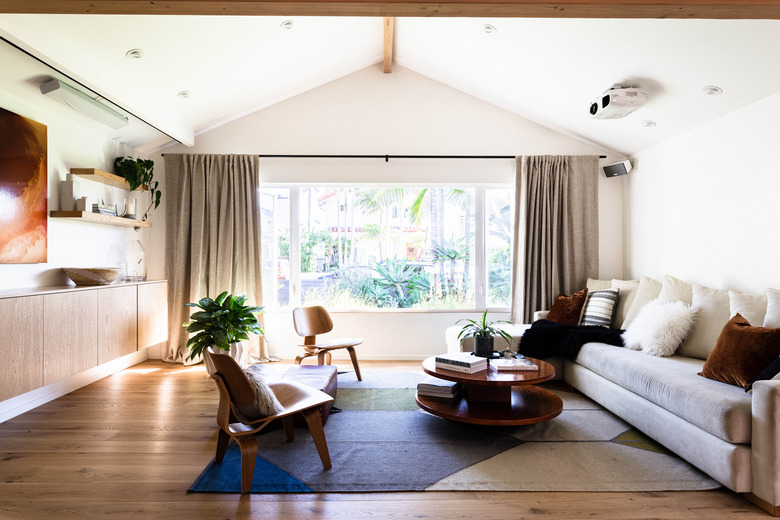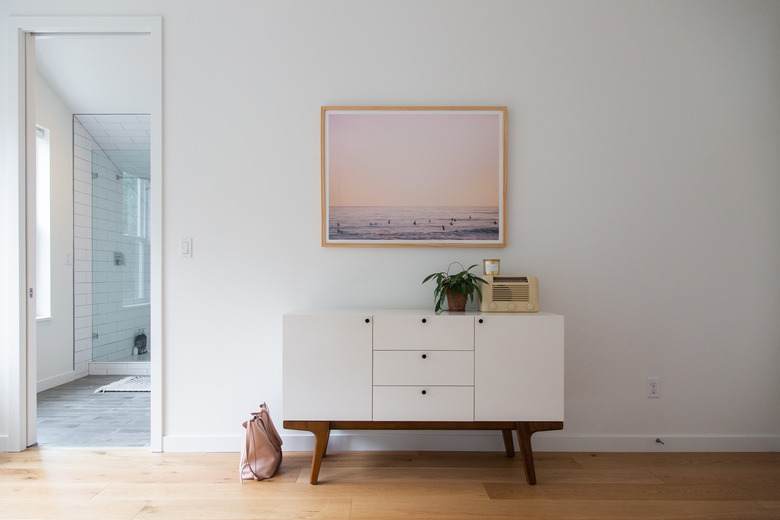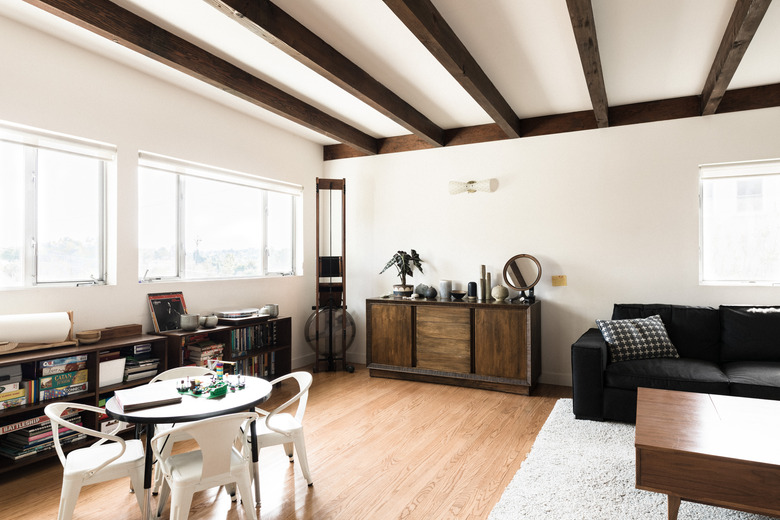Hickory Flooring: A Homeowner's Guide
Hickory is one of the hardest domestic hardwood flooring options, meaning it is durable enough to last for years to come. The grain pattern is distinctive and rustic, and this wood can easily be stained many different colors. When paired with the wide array of finishes and textures available, it is easy to get hickory flooring to suit any interior design style.
About Hickory Wood
About Hickory Wood
Hickory may be best known for its use in barbecuing and smoking meats, but it is becoming increasingly popular as a hardwood flooring option, currently accounting for 5 percent of all hardwood flooring sales. There are many species of hickory trees, including the famous pecan tree, which grows in North America as well as China and India.
The grain pattern and colors of hickory will vary greatly from species to species, with some wood coming out light and creamy, while others are dark brown. Generally speaking, though, hickory is known for having rich, red tones like auburn and cinnamon. While the species may vary in appearance, as a whole, all hickory trees are known for their dense and strong wood.
Hickory Hardwood Flooring Stains and Finishes
Hickory Hardwood Flooring Stains and Finishes
Left untreated, natural hickory has quite a bit of color variation from species to species that can range from a dark-brown heartwood (the densest inner part of the tree) to a creamy-white sapwood (the wood between the bark and the heartwood). While some people like to leave their hickory natural and enjoy a rustic floor appearance with a wide range of colors, most people prefer to reduce the number of contrasting colors. This is why the majority of hickory sold commercially is prestained and prefinished.
Prefinished hickory planks may come in a wide array of shades with finishes ranging from matte to high-gloss, most incorporating a classic or rustic look that works well with the pronounced grain pattern for which hickory is known. Some are even hand-scraped, hand-tooled or wire-brushed, which can create a unique texture that will change the overall look of the planks from the smooth appearance of new wood to a more visually interesting effect that can range all the way to the distressed, antique look you might find on reclaimed hickory hardwood flooring.
Those who prefer to take matters into their own hands and achieve a truly customized look may prefer to purchase unfinished hardwood that they may then stain and finish themselves or hire a professional to do it for them. Because hickory hardwood flooring can be difficult to stain due to the wood's high density, most people are better off having site-finished flooring installed, sanded, stained and finished with polyurethane by a professional. If you want to go this route, be sure to tell your installer that you want to have the floors site-finished so they know to include the cost for this work in their estimate.
As with all hardwood flooring options, it is worth recognizing that high-gloss is best avoided in high-traffic areas since it gets worn down the quickest, losing its luster. As a result, this finish option is best reserved for areas that are not walked on as frequently, such as guest rooms, whereas matte or semi-matte are usually best for busy areas, such as living rooms and kitchens.
Hickory Flooring Options
Hickory Flooring Options
Like most wood flooring, hickory is sold in both solid and engineered forms. Solid hardwood flooring is made entirely from solid pieces of hickory wood that have been cut into thicknesses between 5/16 and 3/4 inch. Engineered hickory flooring is made from plywood that is covered in a thin layer of real hickory wood on top. It comes in thicknesses between 3/8 and 1/2 inch. While engineered flooring is often cheaper than solid hardwood flooring, the fact that the hickory wood layer on top is thin means that these boards can only be sanded and fully refinished one to three times (at best; some cannot be sanded at all), whereas solid hardwood can be refinished a number of times before it needs to be replaced.
It's worth mentioning that it is also possible to get hickory laminate flooring, which features a photographic image of hickory wood glued to a composite wood base. These are not true wood floors, though, as they do not contain any actual hickory and cannot be refinished even once.
Engineered and laminate hickory flooring can be installed using a floating method where the planks are not nailed down to the subfloor but are simply snapped or glued together on top of the floor below. This makes installation drastically easier and less expensive, but these floors can sound more hollow and noisy. It is also worth mentioning that laminate flooring sometimes wears down quicker than the other two options and cannot be refinished like floors made with real wood.
Engineered flooring can also be installed with nails, the same way that traditional solid hardwood floors are installed. Solid hardwood floors can only be installed with nails over wood subflooring (it can glued to concrete subfloors). This is done by nailing through the surface of the first few rows of planks and then nailing down the tongue of the boards to your subfloor.
Grain Patterns and Plank Width
Grain Patterns and Plank Width
Hickory is known for its distinct, dense grain pattern. While many enjoy this striking characteristic, others find it is too busy and rustic for their tastes. When working with narrow planks under 5 inches wide, the number of mismatching grain marks can look notably busy, which is why many people prefer wide-plank flooring, which is cut wider than 5 inches.
The most common narrow-plank width for hickory is between 2 1/4 and 3 inches, whereas wide plank sizes are most frequently sold in 5-inch widths. Planks cut in wide widths tend to give a more unified overall appearance; however, these wide-width planks tend to be more expensive than narrow planks.
Hickory Flooring Hardness
Hickory Flooring Hardness
When it comes to hardwood flooring, hardness directly translates to durability, and as the second-hardest domestic hardwood species, hickory is a notably durable option. The National Wood Flooring Association uses the Janka hardness test to evaluate the hardness of a wood, which measures how much pressure it takes to push a steel ball halfway into a piece of wood. Hickory wood flooring scores 1,820 on the scale, whereas Douglas fir is only rated 660, yellow birch is rated 1,260, white oak is rated 1,360, maple is rated 1,450 and mesquite, the only domestic hardwood that is harder than hickory, is rated 2,345.
What all these numbers mean is that hickory is going to be nearly three times as resistant to dents and other damage as Douglas fir. In fact, hickory flooring that is properly maintained could last a lifetime. While hickory may not be as hard as mesquite, this isn't always a downside since it is still plenty durable, but as wood becomes more and more hard, it can also become harder to work. This can make installation more difficult for nonprofessionals, which is why it is recommended to hire out the installation of your hickory flooring.
It is worth mentioning that while hickory is particularly resistant to dents and deep scratches, the hardness of a wood does not prevent damage to its finish, which is where the majority of daily wear and tear and minor scratches take place. This means hickory will need to be refinished just as often as most other woods. Additionally, it is more susceptible to damage from humidity than many other hardwoods, as it swells and warps easily. If you are planning to install your flooring in a particularly humid region or room, such as the bathroom, it is best to purchase engineered hardwood or avoid hickory flooring entirely.
Hickory Flooring Sustainability
Hickory Flooring Sustainability
While some people seek out the most hard flooring materials they can find, it is worth mentioning that while there are many exotic species that are harder than hickory. Because hickory flooring is domestic, it not only tends to be less expensive than exotic species but is also more eco-friendly.
The fact that it is grown in North America means it does not have to be transported as far, leaving it with a somewhat-smaller carbon footprint. Additionally, hickory is so abundant that it is a very sustainable wood. You can further guarantee that you have sustainably grown wood by seeking out hickory hardwood flooring that is certified by the Forest Stewardship Council.
Hickory Hardwood Flooring Prices
Hickory Hardwood Flooring Prices
Hickory flooring is fairly affordable when compared to particularly hard exotic woods, and it tends to be about average compared to domestic woods. Solid hardwood hickory flooring tends to run around $3 to $9 per square foot, with the quality and cut affecting the final price. While you can save around $2 per square foot by buying unfinished wood, it can cost around $4 per square foot to have it finished on-site, meaning this option will almost always cost more in the long run. Engineered hickory flooring tends to be a little less, running between $2 to $7 per square foot.
While it may be simple enough to install engineered hickory flooring yourself, if you are not experienced with installing hardwood floors you will probably want to hire a professional to install solid hardwood flooring made from hickory. This will add an additional $6 to $8 in labor costs per square foot, bringing the total cost to somewhere between $9 and $17 per square foot.
While these prices may be comparable to other domestic hardwoods, the durability of hickory hardwood flooring means that it can outlast other woods, making it more affordable over time than many less-expensive options.
References
- National Wood Flooring Association: The Homeowner's Handbook to Real Wood Floors
- Home Flooring Pros: Hickory Wood Flooring
- Purdue University: Hickory and Pecan Species
- Networx: Floating Floor Pros and Cons
- Shaw Floors: Quick Guide to Hickory Hardwood Flooring
- Home Reference: The Pros and Cons of Hickory Flooring
- Floor Critics: Oak Flooring Cost & Installation Price



